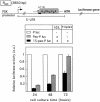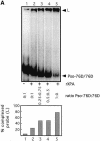Psoralen interstrand cross-link repair is specifically altered by an adjacent triple-stranded structure
- PMID: 14966263
- PMCID: PMC373402
- DOI: 10.1093/nar/gkh267
Psoralen interstrand cross-link repair is specifically altered by an adjacent triple-stranded structure
Abstract
Targeting DNA-damaging agents to specific DNA sites by using sequence-specific DNA ligands has been successful in directing genomic modifications. The understanding of repair processing of such targeted damage and the influence of the adjacent complex is largely unknown. In this way, directed interstrand cross-links (ICLs) have already been generated by psoralen targeting. The mechanisms responsible for ICL removal are far from being understood in mammalian cells, with the proposed involvement of both mutagenic and recombinogenic pathways. Here, a unique ICL was introduced at a selected site by photoactivation of a psoralen moiety with the use of psoralen conjugates of triplex-forming oligonucleotides. The processing of psoralen ICL was evaluated in vitro and in cells for two types of cross-linked substrates, either containing a psoralen ICL alone or with an adjacent triple-stranded structure. We show that the presence of a neighbouring triplex structure interferes with different stages of psoralen ICL processing: (i) the ICL-induced DNA repair synthesis in HeLa cell extracts is inhibited by the triplex structure, as measured by the efficiency of 'true' and futile repair synthesis, stopping at the ICL site; (ii) in HeLa cells, the ICL removal via a nucleotide excision repair (NER) pathway is delayed in the presence of a neighbouring triplex; and (iii) the binding to ICL of recombinant xeroderma pigmentosum A protein, which is involved in pre-incision recruitment of NER factors is impaired by the presence of the third DNA strand. These data characterize triplex-induced modulation of ICL repair pathways at specific steps, which might have implications for the controlled induction of targeted genomic modifications and for the associated cellular responses.
Figures









Similar articles
-
Human XPC-hHR23B interacts with XPA-RPA in the recognition of triplex-directed psoralen DNA interstrand crosslinks.Nucleic Acids Res. 2005 May 24;33(9):2993-3001. doi: 10.1093/nar/gki610. Print 2005. Nucleic Acids Res. 2005. PMID: 15914671 Free PMC article.
-
Human HMGB1 directly facilitates interactions between nucleotide excision repair proteins on triplex-directed psoralen interstrand crosslinks.DNA Repair (Amst). 2009 Jul 4;8(7):865-72. doi: 10.1016/j.dnarep.2009.04.001. Epub 2009 May 14. DNA Repair (Amst). 2009. PMID: 19446504 Free PMC article.
-
Processing of a psoralen DNA interstrand cross-link by XPF-ERCC1 complex in vitro.J Biol Chem. 2008 Jan 18;283(3):1275-1281. doi: 10.1074/jbc.M708072200. Epub 2007 Nov 15. J Biol Chem. 2008. PMID: 18006494
-
Targeting and processing of site-specific DNA interstrand crosslinks.Environ Mol Mutagen. 2010 Jul;51(6):527-39. doi: 10.1002/em.20557. Environ Mol Mutagen. 2010. PMID: 20196133 Free PMC article. Review.
-
Mammalian nucleotide excision repair proteins and interstrand crosslink repair.Environ Mol Mutagen. 2010 Jul;51(6):520-6. doi: 10.1002/em.20569. Environ Mol Mutagen. 2010. PMID: 20658645 Free PMC article. Review.
Cited by
-
Triplex targeted genomic crosslinks enter separable deletion and base substitution pathways.Nucleic Acids Res. 2005 Sep 25;33(17):5382-93. doi: 10.1093/nar/gki851. Print 2005. Nucleic Acids Res. 2005. PMID: 16186129 Free PMC article.
-
Triplex technology in studies of DNA damage, DNA repair, and mutagenesis.Biochimie. 2011 Aug;93(8):1197-208. doi: 10.1016/j.biochi.2011.04.001. Epub 2011 Apr 11. Biochimie. 2011. PMID: 21501652 Free PMC article. Review.
-
Repair of DNA lesions associated with triplex-forming oligonucleotides.Mol Carcinog. 2009 Apr;48(4):389-99. doi: 10.1002/mc.20501. Mol Carcinog. 2009. PMID: 19072762 Free PMC article. Review.
-
Human XPC-hHR23B interacts with XPA-RPA in the recognition of triplex-directed psoralen DNA interstrand crosslinks.Nucleic Acids Res. 2005 May 24;33(9):2993-3001. doi: 10.1093/nar/gki610. Print 2005. Nucleic Acids Res. 2005. PMID: 15914671 Free PMC article.
-
Homology-directed Fanconi anemia pathway cross-link repair is dependent on DNA replication.Nat Struct Mol Biol. 2011 Apr;18(4):500-3. doi: 10.1038/nsmb.2029. Epub 2011 Mar 20. Nat Struct Mol Biol. 2011. PMID: 21423196 Free PMC article.

